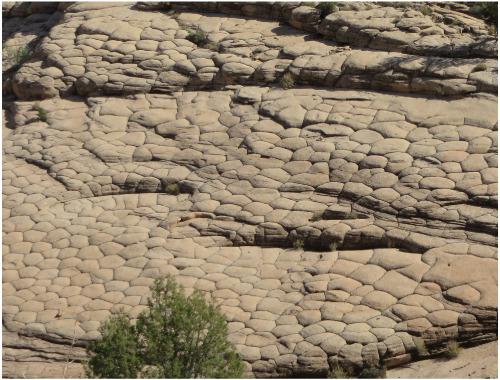当前位置:
X-MOL 学术
›
Earth Surf.Process. Land.
›
论文详情
Our official English website, www.x-mol.net, welcomes your
feedback! (Note: you will need to create a separate account there.)
Surficial fractures in the Navajo sandstone, south‐western USA: the roles of thermal cycles, rainstorms, granular disintegration, and iterative cracking
Earth Surface Processes and Landforms ( IF 2.8 ) Pub Date : 2020-05-11 , DOI: 10.1002/esp.4866 David B. Loope 1 , Garrison R. Loope 2 , Caroline M. Burberry 1 , Clinton M. Rowe 1 , Gerald C. Bryant 3
Earth Surface Processes and Landforms ( IF 2.8 ) Pub Date : 2020-05-11 , DOI: 10.1002/esp.4866 David B. Loope 1 , Garrison R. Loope 2 , Caroline M. Burberry 1 , Clinton M. Rowe 1 , Gerald C. Bryant 3
Affiliation

|
Deep (> 5 m) sheeting fractures in the Navajo sandstone are evident at numerous sites in southern Utah and derive from tectonic stresses. Strong diurnal thermal cycles are, however, the likely triggers for shallow (< 0.3 m) sheeting fractures. Data from subsurface thermal sensors reveal that large temperature differences between sensors at 2 and 15 cm depth on clear summer afternoons are as great as those that trigger sheeting fractures in exposed California granite. Extensive polygonal patterns in the Navajo sandstone are composed of surface‐perpendicular fractures and were produced by contractile stresses. Numerous studies have shown that porewater diminishes the tensile strength of sandstone. Based on our thermal records, we propose that cooling during monsoonal rainstorms triggers polygonal fracturing of temporarily weakened rock. On steep outcrops, polygonal patterns are rectilinear and orthogonal, with T‐vertices. Lower‐angle slopes host hexagonal patterns (defined by the dominance of Y‐vertices). Intermediate patterns with rectangles and hexagons of similar scale are common. We posit that outcropping fractures are advancing downward by iterative steps, and that hexagons on sandstone surfaces (like prismatic columns of basalt) have evolved from ancestral orthogonal polygons of similar scale. In lava flows, fractures elongate intermittently as they follow a steep thermal gradient (the source of stress) as it rapidly moves through the rock mass. In our model, a steep, surficial thermal gradient descends through unfractured sandstone, but at the slow pace of granular disintegration. Through time, as the friable rock on stable slopes erodes, iterative cracking advances into new space. Hexagonal patterns form as new fractures, imperfectly guided by the older ones, propagate in new directions, and vertices drift into a configuration that minimizes the ratio of fracture length to polygon area. © 2020 John Wiley & Sons, Ltd.
中文翻译:

美国西南部纳瓦霍砂岩中的表面裂缝:热循环,暴雨,颗粒崩解和反复裂缝的作用
纳瓦霍砂岩中的深层(> 5 m)薄片裂缝在犹他州南部的许多地方都很明显,并且是由于构造应力引起的。然而,强烈的昼夜热循环可能是导致浅(<0.3 m)薄板裂缝的诱因。来自地下热传感器的数据显示,在晴朗的夏日午后,在2厘米和15厘米深度处的传感器之间的温差与引发裸露的加利福尼亚花岗岩中的片状裂缝的温差一样大。那瓦伙族人砂岩中广泛的多边形图案是由表面垂直裂缝构成的,是由收缩应力产生的。大量研究表明,孔隙水会降低砂岩的抗张强度。根据我们的热力记录,我们建议在季风暴雨期间的冷却触发暂时减弱的岩石的多边形破裂。在陡峭的露头上,多边形图案呈直线和正交,并带有T顶点。下角坡度具有六边形图案(由Y顶点的优势定义)。具有类似比例的矩形和六边形的中间图案是常见的。我们假设露头裂缝通过迭代步骤向下发展,并且砂岩表面上的六边形(如玄武岩的棱柱形)已经从类似比例的祖先正交多边形演化而来。在熔岩流中,裂缝沿着陡峭的热梯度(应力源)随着裂缝快速移动穿过岩体而断续地伸长。在我们的模型中,陡峭的表面温度梯度通过未破裂的砂岩下降,但以颗粒崩解的速度缓慢。随着时间的流逝,随着稳定斜坡上易碎岩石的侵蚀,迭代破解进入了新的领域。六边形图案形成为新的裂缝,在较旧的裂缝的不完全引导下,向新的方向传播,并且顶点漂移为最小化裂缝长度与多边形面积之比的构造。分级为4 +©2020 John Wiley&Sons,Ltd.
更新日期:2020-05-11
中文翻译:

美国西南部纳瓦霍砂岩中的表面裂缝:热循环,暴雨,颗粒崩解和反复裂缝的作用
纳瓦霍砂岩中的深层(> 5 m)薄片裂缝在犹他州南部的许多地方都很明显,并且是由于构造应力引起的。然而,强烈的昼夜热循环可能是导致浅(<0.3 m)薄板裂缝的诱因。来自地下热传感器的数据显示,在晴朗的夏日午后,在2厘米和15厘米深度处的传感器之间的温差与引发裸露的加利福尼亚花岗岩中的片状裂缝的温差一样大。那瓦伙族人砂岩中广泛的多边形图案是由表面垂直裂缝构成的,是由收缩应力产生的。大量研究表明,孔隙水会降低砂岩的抗张强度。根据我们的热力记录,我们建议在季风暴雨期间的冷却触发暂时减弱的岩石的多边形破裂。在陡峭的露头上,多边形图案呈直线和正交,并带有T顶点。下角坡度具有六边形图案(由Y顶点的优势定义)。具有类似比例的矩形和六边形的中间图案是常见的。我们假设露头裂缝通过迭代步骤向下发展,并且砂岩表面上的六边形(如玄武岩的棱柱形)已经从类似比例的祖先正交多边形演化而来。在熔岩流中,裂缝沿着陡峭的热梯度(应力源)随着裂缝快速移动穿过岩体而断续地伸长。在我们的模型中,陡峭的表面温度梯度通过未破裂的砂岩下降,但以颗粒崩解的速度缓慢。随着时间的流逝,随着稳定斜坡上易碎岩石的侵蚀,迭代破解进入了新的领域。六边形图案形成为新的裂缝,在较旧的裂缝的不完全引导下,向新的方向传播,并且顶点漂移为最小化裂缝长度与多边形面积之比的构造。分级为4 +©2020 John Wiley&Sons,Ltd.











































 京公网安备 11010802027423号
京公网安备 11010802027423号